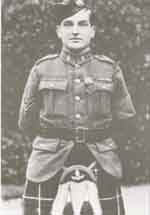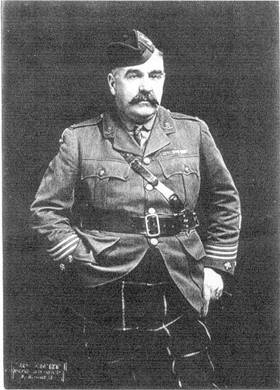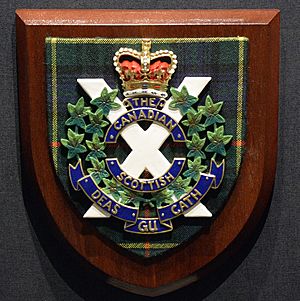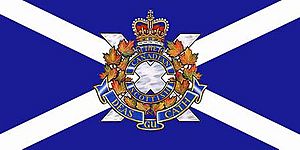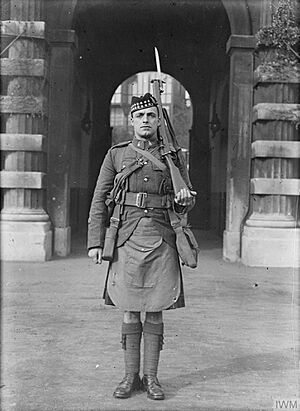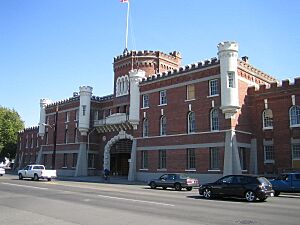Canadian Scottish Regiment (Princess Mary's) facts for kids
Quick facts for kids The Canadian Scottish Regiment(Princess Mary's) |
|
|---|---|

Cap badge of The Canadian Scottish Regiment (Princess Mary's)
|
|
| Active | 1912–present |
| Country | Canada |
| Branch | Canadian Army |
| Type | Light Infantry |
| Role | To close with and destroy the enemy |
| Size | One battalion |
| Part of | 39 Canadian Brigade Group |
| Garrison/HQ | |
| Patron | Mary, Princess Royal and Countess of Harewood |
| Motto(s) | Scottish Gaelic: Deas gu cath ("Ready for the fray" or "ready to sting" – see §Motto) |
| Colours | Red, blue, and green |
| March | The Blue Bonnets over the Border |
| Mascot(s) | Wallace VII, a Šarplaninac−Great Pyrenees cross |
| Equipment | Small arms including the C7 rifle, C9 light machine-gun, C6 machine gun, and M203 grenade launcher, C13 fragmentation grenade, browning Hi power, 84mm Carl gustav. |
| Engagements | First World War Second World War War in Afghanistan |
| Battle honours | See #Battle honours |
| Commanders | |
| Colonel-in-chief | Princess Alexandra, The Honourable Lady Ogilvy |
| Insignia | |
| Tartan | Hunting Stewart |
| Abbreviation | C Scot R |
The Canadian Scottish Regiment (Princess Mary's) is a special part of the Canadian Army. It's a "Primary Reserve" unit, which means its soldiers are part-time. They train for military duties but also have civilian jobs or go to school. This regiment is based on Vancouver Island in British Columbia.
You can find parts of the regiment in Victoria, Nanaimo, and Courtenay, British Columbia. It's a big part of the army reserve units in British Columbia. In fact, it's the largest reserve unit in Western Canada!
This regiment is known as "light infantry." This means they train for quick and agile missions. They learn skills like raids, scouting, ambushes, and even operations from the water or air. They also prepare for different kinds of missions, including fighting, peacekeeping, and helping people in need.
Contents
About the Regiment
The Canadian Scottish Regiment (Princess Mary's) often sends its soldiers to help with Canadian missions around the world. These missions can be for combat or for peacekeeping.
All members of the regiment who served in Afghanistan returned home by 2012. This was a combat mission.
Regiment members have also helped in peacekeeping missions. They have served in places like Egypt, Cyprus, Croatia, and Sierra Leone.
The regiment started on September 3, 1912, as the 88th Regiment, Victoria Fusiliers. Later, in 1914, the 16th (Canadian Scottish) Battalion was formed. It brought together soldiers from different regiments. They simply called it "Canadian Scottish" to show they were all one new team.
This 16th Battalion became famous for its bravery and strong leaders during the First World War. One of its leaders, Lieutenant General Sir Arthur Currie, became a top commander. He led Canadian soldiers to important victories, like the Battle of Vimy Ridge.
Four soldiers from the 16th Battalion earned the Victoria Cross, which is the highest award for bravery.
- Private William Milne bravely attacked enemy machine gun nests at Vimy Ridge in 1917. He died that same day.
- Lance Corporal William Henry Metcalf and Lieutenant Colonel Cyrus Wesley Peck both won their Victoria Crosses on September 2, 1918.
- Piper James Cleland Richardson was only 18 when he joined. He played his bagpipes to encourage his company across a dangerous battlefield. He later went back to get his pipes and disappeared in shellfire. His pipes were found years later and are now in the regimental museum.
After the First World War, the regiment was reorganized and named "The Canadian Scottish Regiment." In 1948, it was given the special title "(Princess Mary's)." This was to honor Mary, Princess Royal and Countess of Harewood, who became the regiment's Colonel-in-Chief in 1930.
During the Second World War, the regiment had two battalions. The 1st Battalion went overseas in 1941. On D-Day, June 6, 1944, some of its soldiers were among the first to land on Juno Beach in France. They advanced further inland than many other units that day. The regiment earned 17 battle honors for its actions in the war.
Regiment's History and Changes
The Canadian Scottish Regiment has changed its name and structure many times over the years. It started as the 88th Regiment (Victoria Fusiliers) in 1912. Over time, it combined with other regiments and battalions.
In 1920, it joined with the 50th Regiment "Gordon Highlanders" and became The Canadian Scottish Regiment. Later, in 1948, it received its current name, The Canadian Scottish Regiment (Princess Mary's).
The regiment also combined with artillery units in 1954. These included the 66th Light Anti-Aircraft Regiment and the 62nd Anti-Tank Battery. This shows how different military units can come together to form a stronger team.
How the Regiment Grew
| Lineage chart | |||||||||||||||||||||||||||||||||||||||||||||||||||||||||||||||||||||||||||||||||||||||||||||||||||||||||||||||||||||||||||||||||||||||||||||||||||||||||||||||||||||||||||||||||||||||||||||||||||||||||||||||||||||||||||||||||||||||||||||||||||||||||||||||||||||||||||||||||||||||||||||||||||||||||||||||||||||||||||||||||||||||||||||||||||||||||||||||||||||||||||||||||||||||||||||||||||||||||||||||||||||||||||||||||||||||||||||||||||||||||||||||||||||||||||||||||||||||||||||||||||||||||||||||||||||||||||||||||||||||||||||||||||||||||||||||||||||||||||||||||||||||||||||||||||||||||||||||||||||||||||||||||||||||||||||||||||||||||||||||||||||||||||||||||||||||||||||||||||||||||||||||||||||||||||||||||||||||||||||||||||||||||||||||||||||||||||||||||||||||||||||||||||||||||||||||||||||||||||||||||||||||||||||||||||||||||||||||||||||||||||||||||||||||||||||||||||||||||||||||||||||||||||||||||||||||||||||||||||||||||||||||||||||||||||||||||||||||||||||||||||||||||||||||||||||||||||||||||||||||
|---|---|---|---|---|---|---|---|---|---|---|---|---|---|---|---|---|---|---|---|---|---|---|---|---|---|---|---|---|---|---|---|---|---|---|---|---|---|---|---|---|---|---|---|---|---|---|---|---|---|---|---|---|---|---|---|---|---|---|---|---|---|---|---|---|---|---|---|---|---|---|---|---|---|---|---|---|---|---|---|---|---|---|---|---|---|---|---|---|---|---|---|---|---|---|---|---|---|---|---|---|---|---|---|---|---|---|---|---|---|---|---|---|---|---|---|---|---|---|---|---|---|---|---|---|---|---|---|---|---|---|---|---|---|---|---|---|---|---|---|---|---|---|---|---|---|---|---|---|---|---|---|---|---|---|---|---|---|---|---|---|---|---|---|---|---|---|---|---|---|---|---|---|---|---|---|---|---|---|---|---|---|---|---|---|---|---|---|---|---|---|---|---|---|---|---|---|---|---|---|---|---|---|---|---|---|---|---|---|---|---|---|---|---|---|---|---|---|---|---|---|---|---|---|---|---|---|---|---|---|---|---|---|---|---|---|---|---|---|---|---|---|---|---|---|---|---|---|---|---|---|---|---|---|---|---|---|---|---|---|---|---|---|---|---|---|---|---|---|---|---|---|---|---|---|---|---|---|---|---|---|---|---|---|---|---|---|---|---|---|---|---|---|---|---|---|---|---|---|---|---|---|---|---|---|---|---|---|---|---|---|---|---|---|---|---|---|---|---|---|---|---|---|---|---|---|---|---|---|---|---|---|---|---|---|---|---|---|---|---|---|---|---|---|---|---|---|---|---|---|---|---|---|---|---|---|---|---|---|---|---|---|---|---|---|---|---|---|---|---|---|---|---|---|---|---|---|---|---|---|---|---|---|---|---|---|---|---|---|---|---|---|---|---|---|---|---|---|---|---|---|---|---|---|---|---|---|---|---|---|---|---|---|---|---|---|---|---|---|---|---|---|---|---|---|---|---|---|---|---|---|---|---|---|---|---|---|---|---|---|---|---|---|---|---|---|---|---|---|---|---|---|---|---|---|---|---|---|---|---|---|---|---|---|---|---|---|---|---|---|---|---|---|---|---|---|---|---|---|---|---|---|---|---|---|---|---|---|---|---|---|---|---|---|---|---|---|---|---|---|---|---|---|---|---|---|---|---|---|---|---|---|---|---|---|---|---|---|---|---|---|---|---|---|---|---|---|---|---|---|---|---|---|---|---|---|---|---|---|---|---|---|---|---|---|---|---|---|---|---|---|---|---|---|---|---|---|---|---|---|---|---|---|---|---|---|---|---|---|---|---|---|---|---|---|---|---|---|---|---|---|---|---|---|---|---|---|---|---|---|---|---|---|---|---|---|---|---|---|---|---|---|---|---|---|---|---|---|---|---|---|---|---|---|---|---|---|---|---|---|---|---|---|---|---|---|---|---|---|---|---|---|---|---|---|---|---|---|---|---|---|---|---|---|---|---|---|---|---|---|---|---|---|---|---|---|---|---|---|---|---|---|---|---|---|---|---|---|---|---|---|---|---|---|---|---|---|---|---|---|---|---|---|---|---|---|---|---|---|---|---|---|---|---|---|---|---|---|---|---|---|---|---|---|---|---|---|---|---|---|---|---|---|---|---|---|---|---|---|---|---|---|---|---|---|---|---|---|---|---|---|---|---|---|---|---|---|---|---|---|---|---|---|---|---|---|---|---|---|---|---|---|---|---|---|---|---|---|---|---|---|---|---|---|---|---|---|---|---|---|---|---|---|---|---|---|---|---|---|---|---|---|---|---|---|---|---|---|---|---|---|---|---|---|---|---|---|---|---|---|---|---|---|---|---|---|---|---|---|---|---|---|---|---|---|---|---|---|---|---|---|---|---|---|---|---|---|---|---|---|---|---|---|---|---|---|---|---|---|---|---|---|---|---|---|---|---|---|---|---|---|---|---|---|---|---|---|---|---|---|---|---|---|---|---|---|---|---|---|---|---|---|---|---|---|---|---|---|---|---|---|---|---|---|---|---|---|---|---|---|---|---|---|---|---|---|---|---|---|---|---|---|---|---|---|---|---|---|---|---|---|---|---|---|---|---|---|---|---|---|---|---|---|---|---|---|---|---|---|---|---|---|---|---|---|---|---|---|---|---|---|---|---|---|---|---|---|---|---|---|---|---|---|---|---|---|---|---|---|---|---|---|---|---|---|---|---|---|---|---|---|---|---|---|---|---|---|---|---|---|---|---|---|---|---|---|---|---|---|---|---|---|---|---|---|---|---|---|---|---|
|
|||||||||||||||||||||||||||||||||||||||||||||||||||||||||||||||||||||||||||||||||||||||||||||||||||||||||||||||||||||||||||||||||||||||||||||||||||||||||||||||||||||||||||||||||||||||||||||||||||||||||||||||||||||||||||||||||||||||||||||||||||||||||||||||||||||||||||||||||||||||||||||||||||||||||||||||||||||||||||||||||||||||||||||||||||||||||||||||||||||||||||||||||||||||||||||||||||||||||||||||||||||||||||||||||||||||||||||||||||||||||||||||||||||||||||||||||||||||||||||||||||||||||||||||||||||||||||||||||||||||||||||||||||||||||||||||||||||||||||||||||||||||||||||||||||||||||||||||||||||||||||||||||||||||||||||||||||||||||||||||||||||||||||||||||||||||||||||||||||||||||||||||||||||||||||||||||||||||||||||||||||||||||||||||||||||||||||||||||||||||||||||||||||||||||||||||||||||||||||||||||||||||||||||||||||||||||||||||||||||||||||||||||||||||||||||||||||||||||||||||||||||||||||||||||||||||||||||||||||||||||||||||||||||||||||||||||||||||||||||||||||||||||||||||||||||||||||||||||||||||
Carrying on History
The Canadian Scottish Regiment (Princess Mary's) keeps the history alive for several older battalions. This means they honor the traditions and achievements of these past units:
- 16th Battalion (Canadian Scottish), CEF
- 48th Battalion (British Columbia), CEF
- 67th Battalion (Western Scots), CEF
- 88th Battalion (Victoria Fusiliers), CEF
- 103rd Battalion, CEF
- 143rd Battalion (British Columbia Bantams), CEF
Regiment's Motto
The regiment's motto is in Gaelic: Deas gu cath. This phrase has two main English meanings. Many people connected to the regiment translate it as "Ready for the Fray." However, official Canadian government sources translate it as "Ready to sting." Both meanings show the regiment's readiness for action.
Important Battles and Missions
First World War Service
At the start of the First World War in 1914, the 50th and 88th Regiments helped protect local areas.
The 16th Battalion (Canadian Scottish) was formed in September 1914. They traveled to Britain and then to France in 1915. They fought bravely in many battles in France and Belgium until the war ended.
Other battalions, like the 48th, 67th, 88th, 103rd, and 143rd, also played important roles. Some became pioneer battalions, helping build things for the army. Others provided new soldiers to support the Canadian forces already fighting. These battalions were later disbanded after the war.
Second World War Service
When the Second World War began in 1939, parts of the regiment were called to protect local areas.
The 1st Battalion of The Canadian Scottish Regiment was sent to Britain in 1941. On D-Day, June 6, 1944, they landed in Normandy, France. They were part of the big invasion to free Europe. They continued fighting across North-West Europe until the war ended in 1945.
Another part, the 2nd Battalion, served in Canada for home defense. After the war, a 4th Battalion was formed to serve in Germany.
After the Wars: Korea and NATO
After the Second World War, the regiment continued to serve. In the early 1950s, some soldiers joined other Canadian units. They served in places like Germany with NATO and in Korea with the United Nations.
Afghanistan Mission
Between 2002 and 2014, many soldiers from the regiment volunteered for missions in Afghanistan. More than 20% of the regiment's strength served in this important mission.
Battle Honours
Battle honors are special awards given to military units for their bravery and success in battles. They are a way to remember important victories and sacrifices. The most important honors are shown in bold on the regiment's flag, called the regimental color.
The old flags of past regiments are kept in churches and museums. This helps preserve their history.
- First World War
-
- Ypres, 1915, '17
- Gravenstafel
- St. Julien
- Festubert, 1915
- Mount Sorrel
- Somme, 1916
- Pozières
- Flers–Courcelette
- Thiepval
- Ancre Heights
- Ancre, 1916
- Arras, 1917, '18
- Vimy, 1917
- Arleux
- Scarpe, 1917, '18
- Hill 70
- Passchendaele
- Amiens
- Drocourt–Quéant
- Hindenburg Line
- Canal du Nord
- Pursuit to Mons
- France and Flanders, 1915–18
A special oak leaf badge was awarded for their actions at Kitcheners' Wood in April 1915.
- Second World War
-
- Normandy Landing
- Putot-en-Bessin
- Caen
- The Orne
- Falaise
- The Laison
- Calais, 1944
- The Scheldt
- Leopold Canal
- Breskens Pocket
- The Rhineland
- Waal Flats
- Moyland Wood
- The Rhine
- Emmerich–Hoch Elten
- Deventer
- Wagenborgen
- North-West Europe, 1944–1945
- South-West Asia
- Afghanistan
Regimental Armoury
The regiment's main building is the Bay Street Armoury in Victoria, British Columbia.
| Site | Date(s) | Designated | Description | Image |
|---|---|---|---|---|
| Bay Street Drill Hall Victoria 48°26′6.75″N 123°21′50.16″W / 48.4352083°N 123.3639333°W |
1912-15 (completed) | 1989 National Historic Sites of Canada; Recognized - 1991 Register of the Government of Canada Heritage Buildings |
This large, fortress-like building is made of brick, steel, and concrete. It has towers and castle-like features. It was built between 1912 and 1915. It houses the regiment's headquarters and other units. |
Regimental Museum
| Established | by Her Royal Highness Princess Alexandra, GCVO, CD, in May 1980. |
|---|---|
| Location | Bay Street Armoury, Room 315, 715 Bay Street, Victoria, British Columbia Canada |
| Type | Regimental Museum |
The Canadian Scottish Regiment (Princess Mary's) Regimental Museum is located in the Bay Street Armoury. It collects and preserves items important to the regiment's history.
The museum has displays of weapons, uniforms, medals, and other artifacts. These items help historians and also teach new soldiers about the regiment's past. You can visit the museum to learn more about this brave regiment.
Freedom of the City
"Freedom of the City" is a special honor given to military units by a city. It means the regiment has the right to march through the city with drums beating and flags flying.
The Canadian Scottish Regiment (Princess Mary's) received this honor in Victoria, British Columbia, in 1964 and 2012. They also received it in Nanaimo, British Columbia, in 1974, 1990, and 2012.
Cadet Corps
Three Royal Canadian Army Cadets corps on Vancouver Island are connected to The Canadian Scottish Regiment (Princess Mary's). These cadet corps help young people learn about leadership and military traditions.
| Corps | Location |
|---|---|
| 1726 RCACC | Comox |
| 2136 RCACC | Victoria |
| 2422 RCACC | Nanaimo |
Cadets in these corps can wear special parts of the regiment's uniform. The regiment also supports them in their activities.
Alliances
The Canadian Scottish Regiment has a special alliance with another military unit. This alliance is with The Royal Regiment of Scotland (6 SCOTS) in the United Kingdom. Alliances help different regiments stay connected and share traditions.
Images for kids
See also
Order of precedence
| Preceded by The Seaforth Highlanders of Canada |
The Canadian Scottish Regiment (Princess Mary's) | Succeeded by The Royal Montreal Regiment |



